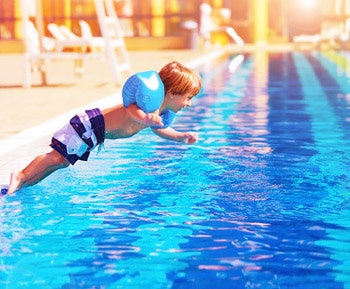
• Reduce Evaporation!
In warmer and dryer areas the annual rate of evaporation can be as high as 6-8 feet per year. When water evaporates, only pure water escapes the pool, leaving behind minerals and chemicals. The faster the evaporation rate, the faster the build-up of solids in the pool, leading directly to the need for draining and replacement of chemicals.
So not only does evaporation mean the direct loss of water from the pool, it degrades the remaining water and hastens the day when that water will have to be intentionally drained.
Many regulatory agencies in drought regions are requiring the use of a solid cover or a liquid cover to reduce evaporation water loss. Solid covers are very effective at reducing evaporation, and even a liquid cover can reduce evaporation up to 50 percent.
• Manage Hardness and TDS
There are certain chemicals that will affect Calcium Hardness and Total Dissolved Solids (TDS) more than others. For example, Calcium Hypochlorite leaves calcium behind in the water, which can build up over time and advance the need for draining. During times of drought it may be advisable to avoid the use of Calcium Hypochlorite based shocks.
Tri-chlor or Di-chlor will leave behind cyanuric acid so it may be best to avoid these as well. Any form of chlorine or shock will leave solids behind in the water. While this can’t be avoided, it is best to try to avoid what may lead to a more immediate need to drain and dilute. A better option for shocking in drought-stricken areas may be liquid chlorine or a non-chlorine shock.
• Keeping Phosphates Low Can Help
Phosphates are a part of TDS so if phosphates are regularly lowered then TDS build-up will be reduced. Higher phosphates can lead to many water quality problems that advance the need for draining and more frequent backwashing. Thus a phosphate removal product can help keep phosphates in check and improve the overall water quality.
• Proactive Removal of Organics

• Remove More Add Less
In drought times the water care mantra needs to be “Remove More, Add Less.” When using any chemical, stop and ask yourself: What is this leaving behind in the water? Oxidizers, clarifiers and phosphate removers are all products that improve water quality while removing contaminants that can cause problems. Avoid over-chlorinating as much as possible. Be aware of how chemicals effect water balance, and choose chemicals that are more neutrally based. Also, avoid cleaners and metal products that contain phosphates. As a pool pro taking the time to be proactive and aware of how chemicals affect the water will help you get through drought times with minimal need for draining.












































